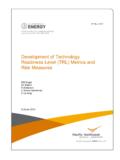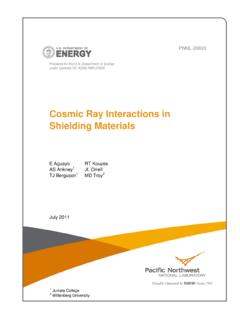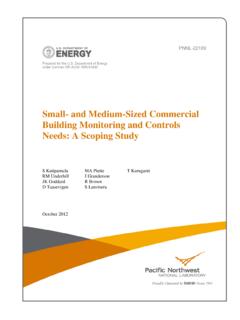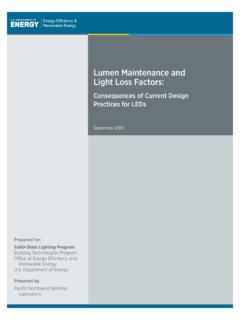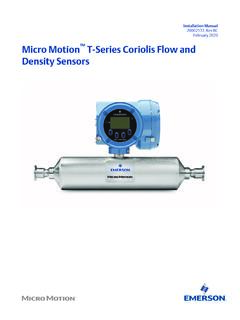Transcription of Material Balance Assessment for Double-Shell Tank Waste ...
1 PNNL-13485 Rev. 1 Material Balance Assessment for Double-Shell Tank Waste Pipeline Transfer Y. Onishi B. E. Wells Hartley Enderlin M. White September 2002 Prepared for the Department of Energy under Contract DE-AC06-76RL01830 DISCLAIMERThis report was prepared as an account of work sponsored by an agency of theUnited States Government. Neither the United States Government nor any agencythereof, nor Battelle Memorial Institute nor any of their employees makes anywarranty, express or implied, or assumes any legal liability or responsibilityfor the accuracy, completeness, or usefulness of any information, apparatus,product, or process disclosed or represents that its use would not infringeprivately owned rights.
2 Reference herein to any specific commercial product,process, or service by trade name, trademark, manufacturer, or otherwise does notnecessarily constitute or imply its endorsement, recommendation, or favoring by theUnited States Government or any agency thereof, or Battelle Memorial views and opinions of authors expressed herein do not necessarily state orreflect those of the United States Government or any agency NORTHWEST NATIONAL LABORATORY operated byBATTELLEfor theUNITED STATES DEPARTMENT OF ENERGY under Contract DE-AC06-76RL01830 Printed in the United States of AmericaAvailable to DOE and DOE contractors from theOffice of Scientific and Technical Information, Box 62, Oak Ridge, TN 37831-0062.
3 Ph: (865) 576-8401fax: (865) 576-5728email: to the public from the National Technical Information Service, Department of Commerce, 5285 Port Royal Rd., Springfield, VA 22161ph: (800) 553-6847fax: (703) 605-6900email: ordering: document was printed on recycled paper.(8/00)PNNL-13485 Rev. 1 Material Balance Assessmentfor Double-Shell Tank WastePipeline TransferY. EnderlinM. WhiteSeptember 2002 Prepared forthe Department of Energyunder Contract DE-AC06-76 RLO 1830 Pacific Northwest National LaboratoryRichland, WA 99352iiiSummaryPacific Northwest National Laboratory researchers developed a Material Balance assessmentmethodology based on conservation of mass to detect possible Waste leaking and mis-routingsduring the pipeline transfer of Double-Shell tank Waste complicated by the variable wasteproperties and tank conditions at Hanford.
4 It is intended to be a backup method to pit only difference between the original report, PNNL-13485, released in March 2001, andthis current report, PNNL-13485 Rev. 1, is that Rev. 1 contains additional information on MicroMotion Coriolis mass flow meters. Otherwise, the two reports are main factors causing variable Waste properties and tank conditions are Waste densitychanges caused by chemical reactions and gas generation/retention/release, the existence of acrust layer, and Waste surface disturbance due to mixer pump operation during the Waste Waste properties and tank conditions were constant, this mass-based Material balancemethodology could be simplified to a volume-based Material Material Balance Assessment methodology was applied to three Waste transfers.
5 AN-105first transfer of 911,400 gallons of in-line diluted supernatant liquid; AN-105 second transferwith 673,000 gallons of liquid Waste ; and AZ-102 slurry transfer of 150,000 gallons. Threeinstrumentation setups were considered: (A) feed and receiver tank levels and diluent flowmeter; (B) flow meter at the beginning of the transfer pipeline and receiver tank level; and (C)diluent, feed, and receiver tank constant Waste properties and tank conditions, the largest Material Balance error withoptimum instrumentation is 2,200 gallons out of 911,400 gallons transferred (AN-105 firsttransfer) using instrumentation setup B with micro motion Elite CMF 200 or T150 mass flowmeter in the transfer pipeline and an Enraf in the receiver uncertainties due to variable Waste properties and tank conditions were included in theanalysis, the Material Balance errors became much larger, ranging from 13,600 gallons ( )
6 With instrumentation setup B to 68,400 gallons ( error) with instrumentation setup Afor the AN-105 first alternative instrumentation setup to reduce these errors would be to have a micro MotionElite CMF 200 or T150 mass flow meter at the both ends of the transfer pipeline. Using thisalternative setup with variable Waste properties and tank conditions, the Material Balance errorfrom the AN-105 first transfer is reduced from 13,600 gallons to 3,900 gallons in the transferpipeline. Thus, depending on the operational accuracy needs, one can select volume-based Material Balance equations for constant Waste properties and tankconditions mass-based Material Balance equations for variable Waste properties and tank conditionswith one or combinations of the three instrumentation setups (A,B, C)iv mass-based Material Balance equations for variable Waste properties and tank conditionswith the alternative instrumentation setup having mass flow meters at both ends of thetransfer Introduction.
7 Development of Material Balance Instrumentation Setups .. Material Balance General Material Balance Equations .. Integration Forms .. Simplified Material Balance Equations under Constant Waste Properties and Tank Material Balance Applications .. Transfer Instrumentation .. Electromagnetic Flow Meters .. Coriolis Mass Flow Enraf Buoyancy Statistical Assessment Application Results and Evaluations .. Constant Waste Properties and Tank Conditions .. Summary of Input Data .. Waste Material Balance Evaluation .. Variable Waste Properties and Tank Conditions.
8 Factors Affecting Accurate Measurements of the Waste Determination of Height Measurement Accuracy .. Factors Affecting Accurate Measurements of the Waste Flow Rate .. Methods to Determine Waste Determination of Waste Density .. Summary of Input Data .. Waste Material Balance Evaluation .. Alternative Instrumentation Setup .. Material Balance Equations .. Results and Evaluation .. Transfer System Implications of Alternative Instrumentation Summary and Conclusions .. References .. 43 Appendix A: The micro motion TSM Calibration System .. B: Traceability and Uncertainty Analysis for a Calibration Processfor Flowmeters, Using Coriolis Flowmeters as Reference.
9 C: Test Report .. D: Informal Collection of Users of micro motion Meters in RadioactiveEnvironments and/or Nuclear Applications .. E: Materials in CMF 100 and T 100 micro motion Meters .. Waste Transfer System and Associated Instrumentation .. Percent Error as a Function of the Percent of Full-Scale Mass Flow Rate for Elite Series micro motion Flow Meters .. Zeolite Slurry Mass Flow Rate and Percent Error Between Test Tank Load Cell Readings and Integral of 1-in. micro motion CMF Meter Readings as a Function of Time .. Tank Wall Waste Retention During Transfer 1.
10 Tank Wall Waste Retention After Transfer Waste Surface Irregularity Effect on Height Measured and Predicted Supernatant Chemical Concentrations for AN-105 .. Predicted Dry Solid Concentration for AN-105 Supernatant Diluted at 56% by Volume with Water .. Alternative Instrumentation Setup .. Instrumentation Errors .. Transfer Parameters .. Instrumentation Material Balance Error for Transfer 1 .. Instrumentation Material Balance Error for Transfer 2 .. Instrumentation Material Balance Error for Transfer 3 .. SY-101 Transfer Volume Comparison.





